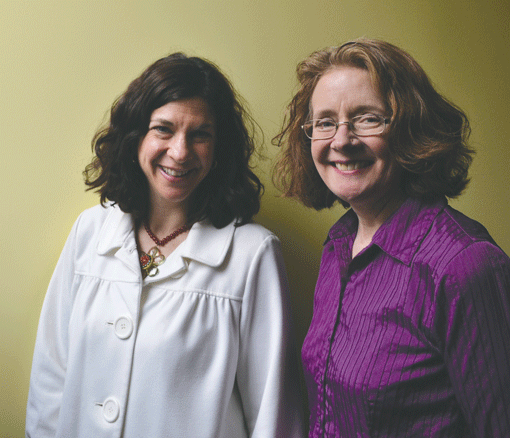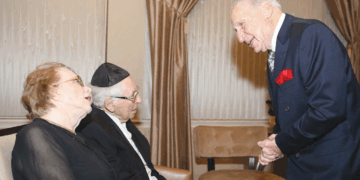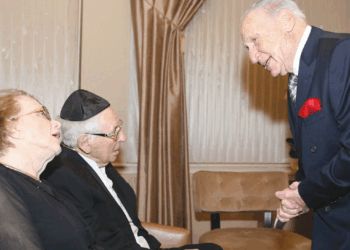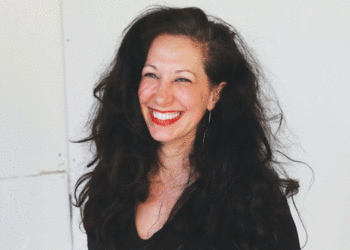By MORDECAI SPECKTOR
My father, of blessed memory, had a significant hearing loss late in life, likely a result of many decades of carpentry work. The continual noise from hammering nails and operating a circular saw, without ear protection, caused his sensorineural hearing loss (SNHL). In other words, loud noise over many years damaged his cochlea — the portion of the inner ear which converts the physical vibrations of sound waves into electrical information for the brain to recognize as sound — or the neural pathway from his inner ear to his brain.
He could have remedied his sensory deprivation with hearing aids, but for some reason he resisted that solution.
I’ve also worked as a carpenter, and probably likewise damaged my hearing a bit. There has also been some loud rock music along the way. So in the tradition of participatory journalism, last week I went for a hearing evaluation at Chears Audiology, a new clinic in St. Louis Park. This is a report on my experience — which produced some surprising results.
Kim Fishman, proprietor of Chears Audiology, has been a practicing audiologist for 18 years. A native of St. Louis, Mo., she attended Washburn High School and the U of M, where she majored in biology. Fishman tried her hand at various pursuits — for a time, she considered getting a doctorate in literature — before returning to school to become a speech pathologist. “It’s what makes me a different audiologist,” she comments about her varied background.
At Chears Audiology, Fishman offers a relaxed setting, and a cup of coffee. She tries to get to know each patient and find out what he or she wants.

As per the example of my father, Fishman knows that some patients have a “huge resistance” to wearing hearing aids. “If you wear hearing aids, you’re old,” she sums up one line of thinking, in the psychological complex about hearing loss. Others worry about the expense of hearing aids.
Some patients complain of a buzzing in the ear, or feeling dizzy, she recounts. Sometimes it is simply a matter of wax in the ear that is pushing against the ear canal and causing dizzy spells. In most cases, Fishman advises her patients to get a hearing evaluation before seeing an ear, nose and throat specialist.
Fishman says that Chears Audiology, which has been open for eight months, is intended to offer a better concept of helping people “to embrace their sensory deprivation.”
“If you have a hearing loss and you’re not doing anything about it, it’s not a good thing,” she says.
And then it’s time for my audiometry exam.
Martha Takata, who has completed her audiology coursework and is now working as an “audiology extern” at Chears, shows me into the hearing test chamber — not a soundproof booth, but a roomy box with noise-dampening materials on the interior. I sit on a chair and Takata fits me with ear buds. The test consists of a recorded voice saying various words, then I have to repeat the words. In another part of the exam, I hold an electronic control and press a button whenever I can hear tones played at various frequencies. It’s all completely painless.
Fishman shows me my audiogram, a printed graph, which indicates that there is a drop-off in my hearing of high frequencies.
That sensory deficit can be corrected with hearing aids, and Fishman fixes me up with the Cadillac of hearing aids from a company called GN ReSound. The digital devices are a sporty metallic blue color and are worn behind the ear with a clear tube looping into a very tiny earpiece.
After the hearing aids are in place, I ask Fishman and Takata to pose for some photos. I notice that the shutter on my digital camera is exceptionally loud. Of course, they both point out that I’m wearing hearing aids, which enhance the sound of the shutter clicking.
Actually, the hearing aids turn up the volume on reality, and bring up the treble sounds that I had been missing. Water running, a light switch being flipped, the clacking of my computer keyboard, a zipper — all these sounds were heard with new clarity. I could hear people talking behind me exceptionally well.
 Fishman also showed me an add-on, the ReSound Unite Mini Microphone, a device that can transmit speech directly to the hearing aids, or can function as an audio streamer, bringing music from an iPod or computer into the hearing aids and your ears.
Fishman also showed me an add-on, the ReSound Unite Mini Microphone, a device that can transmit speech directly to the hearing aids, or can function as an audio streamer, bringing music from an iPod or computer into the hearing aids and your ears.
As for the self-image issue, I came home wearing the hearing aids last Thursday, and told my wife about the hearing evaluation. I turned my head this way and that way, and she didn’t notice the devices. Neither did my eldest son that evening. At our Kabbalat Shabbat dinner, with six us around the table, I mentioned my audiometry exam. When no one said anything, I announced that I was wearing hearing aids. I popped out one of the shiny blue gizmos and showed it to everyone.
The lesson here is that these amazing little hearing aids are quite unobtrusive. No one seems to notice that I’m wearing them.
On the downside, Fishman said that the pair of hearing aids that I’ve taken for a trial spin are expensive. And they are not covered by my medical insurance. Of course, hearing aids come in a range of prices, so something more affordable likely is available.
As the AJW goes to press this week, I’m still doing my real world test of the hearing aids. They really help in the situations where I have noticed difficulty in hearing clearly, especially in restaurants or rooms with many other conversations and background noise.
Perhaps hearing aids will be the solution for my sensory deprivation. I’ll be seriously thinking about it.
***
Kim Fishman can be reached at 952-767-0672. For information, go to: chearsaudiology.com. Chears Audiology is located at 5808 W. 36th St., St. Louis Park.

















